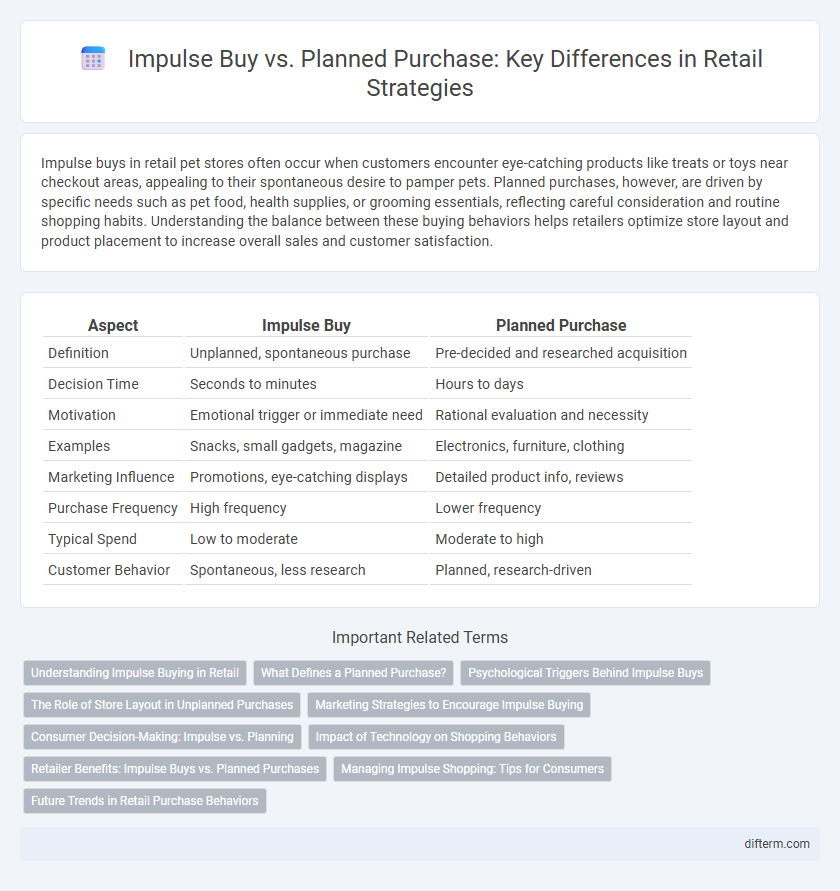Impulse buys in retail pet stores often occur when customers encounter eye-catching products like treats or toys near checkout areas, appealing to their spontaneous desire to pamper pets. Planned purchases, however, are driven by specific needs such as pet food, health supplies, or grooming essentials, reflecting careful consideration and routine shopping habits. Understanding the balance between these buying behaviors helps retailers optimize store layout and product placement to increase overall sales and customer satisfaction.
Table of Comparison
| Aspect | Impulse Buy | Planned Purchase |
|---|---|---|
| Definition | Unplanned, spontaneous purchase | Pre-decided and researched acquisition |
| Decision Time | Seconds to minutes | Hours to days |
| Motivation | Emotional trigger or immediate need | Rational evaluation and necessity |
| Examples | Snacks, small gadgets, magazine | Electronics, furniture, clothing |
| Marketing Influence | Promotions, eye-catching displays | Detailed product info, reviews |
| Purchase Frequency | High frequency | Lower frequency |
| Typical Spend | Low to moderate | Moderate to high |
| Customer Behavior | Spontaneous, less research | Planned, research-driven |
Understanding Impulse Buying in Retail
Impulse buying in retail occurs when consumers make spontaneous, unplanned purchases driven by emotions or immediate desires, often triggered by product placement, attractive packaging, or promotional offers. Retailers leverage this behavior by strategically positioning impulse items near checkout counters or in high-traffic areas to maximize visibility and appeal. Understanding impulse buying patterns enables retailers to optimize store layout, increase average transaction value, and enhance overall sales performance.
What Defines a Planned Purchase?
A planned purchase is defined by deliberate consumer intent, where shoppers research products, compare prices, and set budgets before buying. It often involves higher-cost items or essential goods that fulfill specific needs, with decisions influenced by product reviews, brand reputation, and long-term value. Retailers optimize planned purchases through targeted promotions, detailed product information, and loyalty programs.
Psychological Triggers Behind Impulse Buys
Impulse buys are primarily driven by emotional triggers such as scarcity, urgency, and the desire for instant gratification, which activate dopamine release in the brain, reinforcing reward-seeking behavior. Visual merchandising, strategic product placement, and limited-time offers exploit these psychological triggers by creating a sense of scarcity and urgency that compels consumers to make spontaneous purchases. Understanding the role of emotional arousal and cognitive biases like loss aversion allows retailers to design store layouts and marketing strategies that effectively convert browsing into impulse buying.
The Role of Store Layout in Unplanned Purchases
Store layout significantly influences unplanned purchases by strategically positioning high-demand and visually appealing products along common traffic paths, increasing impulse buys. Endcaps and checkout areas are crucial zones where retailers place low-cost, attractive items to trigger spontaneous decisions. Effective store design leverages shopper psychology to maximize exposure to products, thereby boosting overall sales through unplanned purchasing behavior.
Marketing Strategies to Encourage Impulse Buying
Retail marketing strategies to encourage impulse buying leverage product placement, sensory appeal, and limited-time offers to trigger spontaneous purchases. Utilizing colorful packaging, strategically positioning items near checkout counters, and deploying targeted digital ads based on browsing behavior increases the likelihood of unplanned sales. Implementing loyalty programs and flash sales further enhances impulse purchase frequency by creating urgency and perceived value.
Consumer Decision-Making: Impulse vs. Planning
Impulse buy decisions typically happen spontaneously, driven by emotional triggers and immediate desire, often influenced by in-store promotions and product placement. Planned purchases involve deliberate information gathering, comparison of alternatives, and evaluation based on price, quality, and brand reputation, reflecting a more rational decision-making process. Understanding the psychological and situational factors behind both can help retailers tailor marketing strategies to effectively target consumer behavior patterns.
Impact of Technology on Shopping Behaviors
Technology significantly influences shopping behaviors by enabling seamless impulse purchases through personalized recommendations and one-click payment options, increasing spontaneous spending. Mobile apps and digital wallets streamline planned purchases with features like price comparison, product reviews, and shopping lists, fostering informed decision-making. Data analytics and AI power targeted advertisements that blur the lines between impulsive and intentional shopping, transforming the retail landscape.
Retailer Benefits: Impulse Buys vs. Planned Purchases
Impulse buys generate immediate revenue by leveraging in-store placement and emotional triggers, increasing overall sales volume and profit margins. Planned purchases provide retailers with predictable demand patterns and opportunities for targeted marketing campaigns, enhancing inventory management and customer loyalty. Combining both strategies maximizes revenue streams and optimizes retail space utilization.
Managing Impulse Shopping: Tips for Consumers
Managing impulse shopping requires setting a clear budget and sticking to a pre-made shopping list to avoid unnecessary purchases. Consumers benefit from eliminating distractions like smartphones or store promotions that trigger spur-of-the-moment decisions. Utilizing apps to track spending and practicing mindful shopping habits empower buyers to make intentional, value-driven purchases.
Future Trends in Retail Purchase Behaviors
Advancements in AI-driven personalization and real-time analytics are reshaping impulse buy patterns by delivering highly targeted recommendations at the point of sale. Enhanced mobile payment systems and seamless omnichannel experiences enable consumers to transition effortlessly between impulsive and planned purchases. Increasing consumer demand for sustainability is also influencing future retail behaviors, with buyers gravitating toward brands that support conscious consumption even during spontaneous shopping moments.
Impulse Buy vs Planned Purchase Infographic

 difterm.com
difterm.com